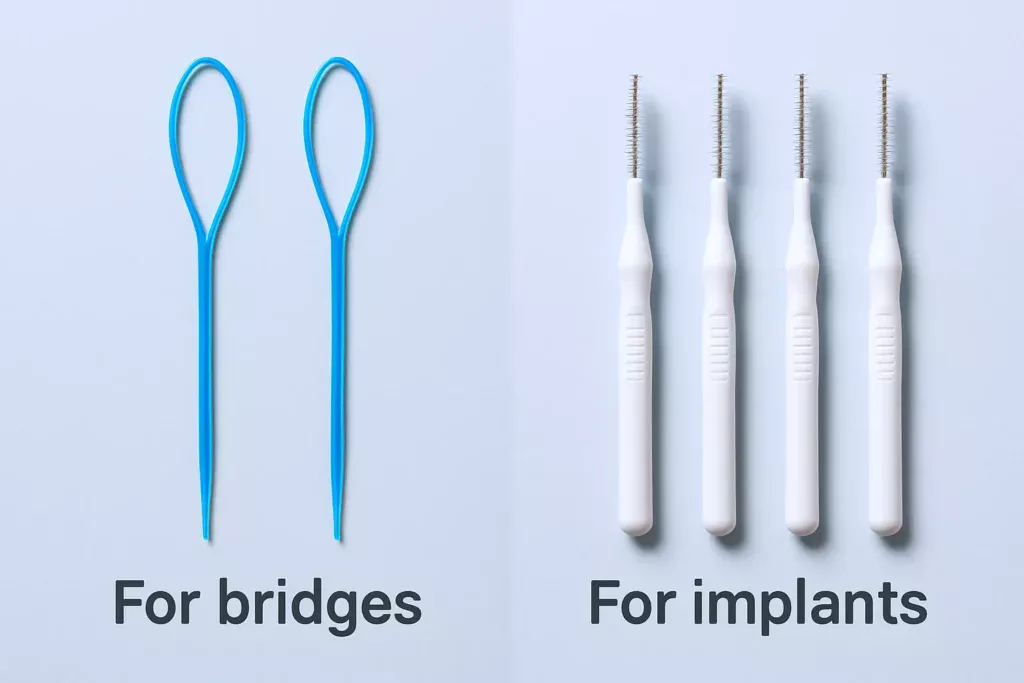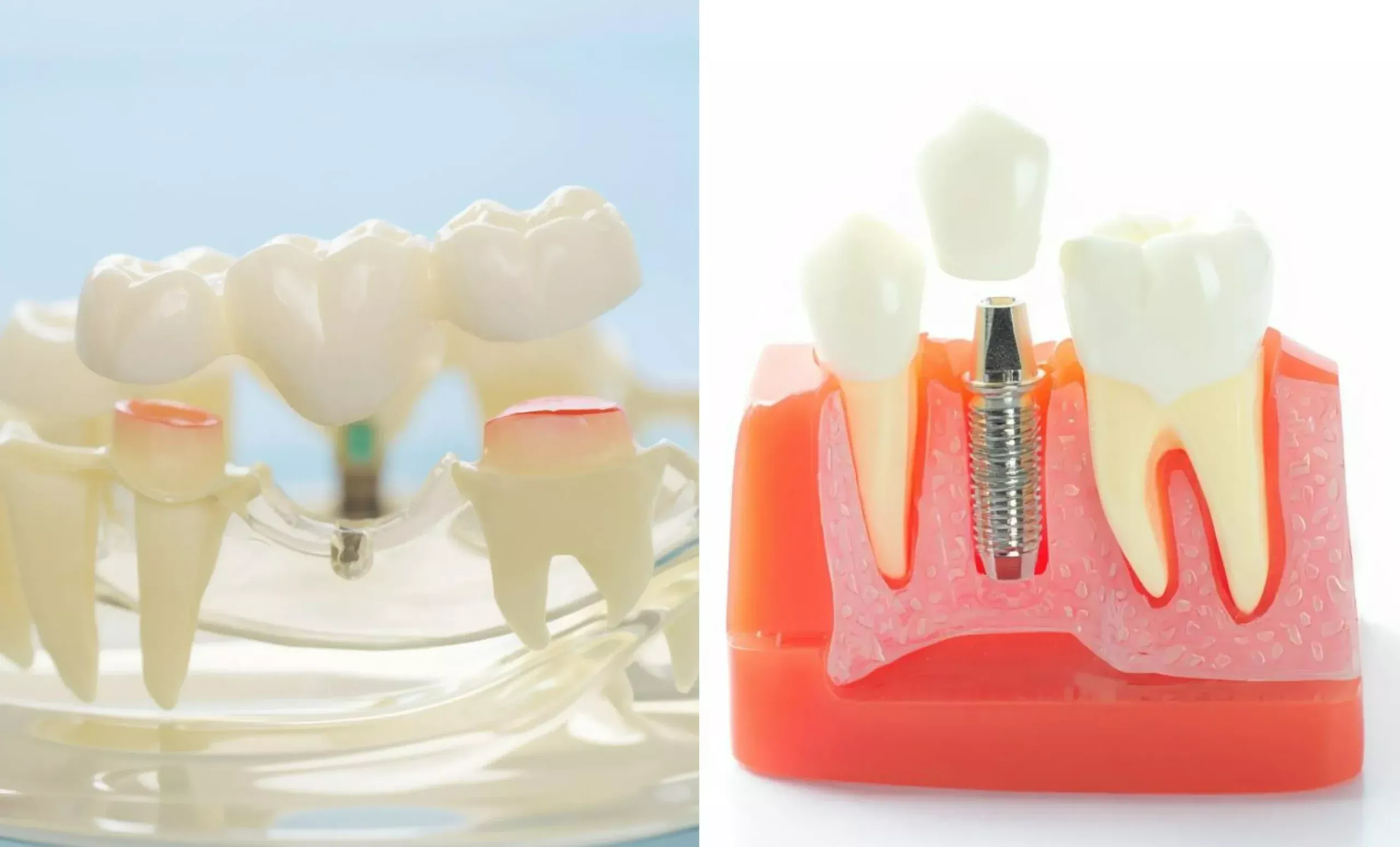Tooth loss is more than a cosmetic concern. It affects chewing, speech, and even the long-term health of your jawbone. When considering tooth replacement options, dental implants and dental bridges are often the two most common solutions. Each has its advantages, limitations, and suitability depending on your oral health and lifestyle. Understanding the facts behind both treatments can help you make a well-informed decision.
How each option replaces missing teeth
Dental bridges and dental implants are both used to replace missing teeth, but they differ significantly in how they are attached and how they function.
- Bridges are fixed to adjacent teeth.
- Implants are surgically placed into the jawbone, acting as artificial tooth roots.
Implants typically offer a more long-term solution and better preserve jawbone health, but they are more expensive and require surgery. Bridges, on the other hand, are generally less costly and can be fitted more quickly, but they may require altering healthy adjacent teeth and can potentially lead to bone loss around the missing tooth.
Dental bridges
- Attachment: Supported by crowns placed on adjacent teeth, effectively “bridging” the gap.
- Procedure: Involves preparing the adjacent teeth (filing them down) and cementing crowns onto them.
- Pros:
- Less expensive than implants
- Quicker to fit
- No surgery required
- Cons:
- May damage healthy adjacent teeth
- Risk of bone loss around the missing tooth
- Typically lasts 5–15 years
Dental implants
- Attachment: Titanium posts surgically placed into the jawbone
- Procedure: Implantation followed by healing (osseointegration) before crown placement
- Pros:
- Natural look and feel
- Preserves jawbone health
- Can last for decades
- Cons:
- Higher cost
- Requires surgery
- Longer treatment time
Which to choose?
The best option depends on the location of the missing tooth, the health of your jawbone, your budget, and personal preference. At Waldron Dental, clinicians offer both treatment options tailored to your long-term dental health.
Jawbone health
One of the most significant differences is how each treatment affects the jawbone:
- Implants: Stimulate the jawbone like natural roots, promoting bone regeneration.
- Bridges: Do not contact the jawbone and offer no stimulation, potentially causing resorption.
According to the National Institute of Dental and Craniofacial Research (NIDCR), up to 25% of jawbone width can be lost within the first year after tooth loss if untreated. This loss of bone density may also affect facial structure and create an aged appearance over time.
In contrast, the presence of a dental implant stimulates the surrounding bone through chewing forces, preserving the jawbone’s strength and shape. This makes implants especially valuable in long-term oral health planning.
Protecting adjacent teeth
Bridges require modification of neighbouring teeth:
- Bridges: Abutment teeth are filed down to support the bridge, permanently altering them.
- Implants: Do not affect adjacent teeth, making them ideal for preserving natural structure.
This preservation of healthy enamel and tooth structure makes implants a favourable choice for individuals with otherwise strong natural teeth. The decision often rests on whether the adjacent teeth are already in need of crowns or restorations.
Treatment time and recovery
Dental bridges
- Can usually be completed in 2–3 weeks
- Minimally invasive
- Local anaesthesia is typically sufficient
- Immediate improvement in chewing and speech
Dental implants
- May take 3–9 months, depending on complexity
- Healing period required for osseointegration
- May involve bone grafting
- Temporary crown may be used during healing
Though the implant process takes longer, the outcome is often more stable and natural-feeling. For patients needing quick results, a bridge may offer an advantage, but those planning for long-term benefits may prefer the patience required with implants.
Durability and maintenance
Longevity
- Implants: Last 20+ years with proper care (90–95% success rate over 10 years – Oral Health Foundation)
- Bridges: Last 5–15 years, depending on oral hygiene and material quality
Implants are generally constructed from titanium and ceramic, materials known for durability and biocompatibility. Bridges, while robust, may need earlier replacement due to wear, decay of supporting teeth, or changes in oral anatomy.
Maintenance
- Implants:
- Flossing and brushing like natural teeth
- May require interdental brushes or water flossers
- Bridges:
- May require floss threaders to clean underneath
- Risk of decay in abutment teeth

Failure to clean under a bridge can lead to plaque accumulation, gum inflammation, and even bridge failure. Implants require routine cleaning but typically have fewer hygiene-related complications.
Cost comparison in the UK
- Implants: £2,000–£2,500 per tooth
- Bridges: £500–£1,200 for a three-unit bridge
NHS coverage
- Bridges: May be covered if clinically justified
- Implants: Typically private unless part of reconstructive treatment
Cost is often a deciding factor. While bridges offer a lower upfront cost, implants may be more economical long-term when longevity and reduced need for retreatment are considered. For guidance on NHS dental services, visit the NHS website.
Aesthetics and comfort
- Implants: Appear to emerge from gums like natural teeth
- Bridges: May create visible gaps or gum recession over time
- Comfort: Implants offer better bite accuracy and tactile feedback
The seamless integration of implants into the gumline enhances their aesthetic appeal. Patients often report greater satisfaction in terms of feel and bite force with implants compared to bridges.
Candidate suitability
Ideal for implants
- Adults with fully developed jaws
- Sufficient bone density
- Non-smokers or willing to stop
- Good oral hygiene habits
Ideal for bridges
- Medically unable to undergo surgery
- Strong adjacent teeth
- Shorter treatment timeline preferred
Children and teens typically aren’t suitable for implants until jaw growth is complete. In some cases, bridges can be used as temporary restorations until full development occurs.
Implant-supported bridges: an alternative
Used when multiple teeth are missing in a row, this approach:
- Requires fewer implants
- Avoids damage to neighbouring teeth
- Preserves jawbone health
- Provides stable, lasting restoration
Suitable for:
- Gaps of three or more adjacent missing teeth
- Patients with sufficient jawbone volume
- Those seeking an alternative to removable dentures
This option offers the stability of implants with the coverage of bridges, making it an increasingly popular choice in restorative dentistry.
Aftercare and recovery
Dental bridges
- Minimal recovery
- Possible short-term sensitivity
- Avoid overly hard or sticky foods
Dental implants
- Swelling and bruising post-surgery
- Full recovery may take months
- Importance of routine check-ups
Post-treatment care tips:
- Brush and floss daily
- Use dentist-recommended tools
- Attend regular dental reviews
- Avoid smoking during recovery – here’s why
Following professional aftercare instructions can significantly extend the life of both implants and bridges. Regular cleanings and early detection of issues will keep your dental work in excellent condition.
Final thoughts

Whether you opt for a dental bridge or a dental implant, the decision should be based on a clear understanding of your oral health, treatment expectations, and long-term goals. Implants offer superior bone preservation, longevity, and natural aesthetics, while bridges remain an effective and accessible solution for those seeking a quicker or non-surgical option. Both treatments have their place, and a personalised consultation with your dentist will ensure your chosen path aligns with your needs.
If you’re unsure where to begin, Waldron Dental welcomes patients for a thorough consultation, where your oral health will be assessed and the best treatment options clearly explained. Book your visit today to take the first step toward restoring a healthier, more confident smile, supported by expert care every step of the way.













